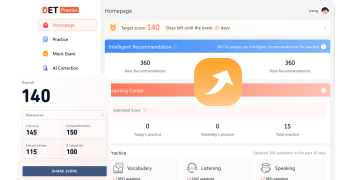Maîtriser la section « Écrire à propos de la photo » dans le test d'anglais Duolingo
Le test d'anglais Duolingo est devenu une référence essentielle pour les locuteurs non natifs souhaitant démontrer leur maîtrise de l'anglais. Son accès en ligne pratique et ses résultats rapides en font un favori parmi les étudiants et les professionnels recherchant des admissions ou des opportunités dans des environnements anglophones. Un composant unique et stimulant de ce test est la section « Write About the Photo », qui évalue la fluidité du candidat ainsi que sa capacité à penser rapidement et à transmettre ses observations de manière concise et claire.
Cette section présente un instantané sincère de la vie quotidienne - une scène à laquelle on peut passer sans y prêter attention. Pourtant, sous l'œil vigilant du test, ce moment banal devient la toile sur laquelle les candidats doivent peindre leurs mots, détaillant l'histoire cachée avec précision et créativité. En seulement une minute, la capacité à décrire une photo peut ouvrir les portes des universités et des opportunités d'emploi dans le monde entier.
Ce post explorera des stratégies pour maîtriser cette section, en veillant à ce que votre description se démarque. Nous couvrirons des conseils essentiels pour rédiger des descriptions vivantes qui capturent l'essence de l'image et reflètent votre maîtrise linguistique. Que vous soyez un locuteur expérimenté en anglais ou en train de perfectionner votre compétence, maîtriser l'art de la description est la clé pour exceller au test d'anglais Duolingo.
Restez à l'écoute alors que nous explorons comment transformer une simple image en une opportunité de présenter la richesse de votre vocabulaire anglais et la précision de vos compétences d'observation.
1. Comprendre la Question
La tâche « Write About the Photo » du test d'anglais Duolingo est aussi simple qu'elle est profonde. Les candidats sont présentés avec une photographie et doivent rédiger une description de celle-ci en une minute. Bien que les instructions soient simples, l'exécution est là où réside le défi. Cette section ne concerne pas seulement ce que vous voyez, mais comment vous interprétez et transmettez ces détails visuels par le langage.
Pour vraiment comprendre la question, vous devez reconnaître qu'elle a un double objectif. Premièrement, elle évalue votre réponse immédiate aux stimuli visuels, testant votre capacité à organiser rapidement vos pensées et à les traduire en un langage descriptif cohérent. Deuxièmement, elle évalue vos compétences en littératie anglaise, en particulier votre gamme de vocabulaire, la structure des phrases et la précision orthographique.
La clé pour maîtriser cette question est de trouver un équilibre entre la vitesse et la substance. Votre description doit aller au-delà de la simple identification des objets dans la photo. Le test est conçu pour mesurer votre capacité à communiquer efficacement, ce qui inclut l'utilisation de structures de phrases variées, un langage descriptif riche et une grammaire précise. Par exemple, décrire un homme marchant un chien le long d'une rue animée de la ville devrait inclure des détails sensoriels, des émotions possibles et des actions qui animent la scène.
Comprendre cette question signifie se préparer à interagir avec la photo à un niveau plus profond. Vous devriez être prêt à décrire non seulement ce qui est immédiatement apparent, mais aussi à inférer et à dépeindre ce qui pourrait être suggéré par la scène. Par exemple, les expressions sur les visages des gens, le temps qu'il fait ou l'atmosphère du cadre peuvent tous fournir un contexte qui enrichit votre description.
Pendant que vous vous préparez pour cette section, la pratique est primordiale. Familiarisez-vous avec une variété de photographies et mettez-vous au défi de les décrire dans la limite d'une minute. Cela améliorera non seulement votre vitesse mais encouragera également à penser de manière critique et créative sous pression.
Dans les sections suivantes, nous vous fournirons des conseils pratiques et des exercices qui peuvent améliorer vos capacités descriptives et vous préparer à exceller dans cette partie unique et perspicace du test d'anglais Duolingo.
2. Conseils pour une Description Réussie
Réaliser une description réussie dans la tâche « Write About the Photo » du test d'anglais Duolingo repose sur quelques stratégies clés. Voici comment vous pouvez vous préparer à créer des descriptions à la fois efficaces et efficientes :
- Pratiquer vos Compétences d'Observation : Avant le test, passez du temps à observer diverses photographies et à noter les détails que vous voyez. Entraînez-vous à distiller l'essence de la photo dans un langage descriptif qui peint un tableau vivant pour le lecteur.
- Enrichir votre Vocabulaire Descriptif : La richesse de votre description dépendra en grande partie de la variété des mots dont vous disposez. Apprenez des adjectifs et des verbes qui peuvent décrire précisément les couleurs, les formes, les émotions et les actions.
- Structurer votre Description : Même sous des contraintes de temps, avoir un plan mental peut aider. Commencez par une déclaration générale sur la scène, puis passez aux détails spécifiques, et terminez par une observation intéressante ou un commentaire qui apporte une conclusion.
- Engager les Sens : Ne vous concentrez pas uniquement sur ce qui est visible. Mentionnez les sons potentiels, les odeurs ou l'atmosphère de l'environnement pour créer une description multisensorielle.
- Pratiquer la Rédaction Rapide (Dactylographie) : Des exercices de dactylographie chronométrés peuvent vous aider à vous habituer à penser et taper rapidement. Utilisez un chronomètre pour simuler les conditions du test et réviser votre travail pour identifier les points à améliorer. Vous pouvez utiliser des sites web comme www.typing.com ou www.keybr.com pour pratiquer vos compétences en dactylographie.
- Éviter les Pièges Courants : Évitez les déclarations génériques ou les listes d'objets dans la photo. Concentrez-vous plutôt à créer une narration ou une déclaration thématique qui relie les éléments ensemble.
- Utiliser un Langage Comparatif et Métaphorique : Les similitudes et les métaphores peuvent ajouter de la profondeur à vos descriptions et montrer des compétences linguistiques avancées. Par exemple, au lieu de dire « The sky is blue, » vous pourriez dire « The sky is as blue as a robin’s egg. »
- Revoir la Grammaire et la Ponctuation : Les erreurs peuvent diminuer la qualité de votre description. Assurez-vous que vous êtes à l'aise avec les règles de base de la grammaire et de la ponctuation pour éviter les erreurs simples.
- Comprendre les Critères de Notation : Familiarisez-vous avec la façon dont les réponses sont évaluées. Savoir ce que le système d'évaluation recherche peut vous aider à adapter votre pratique et vos réponses lors du test en conséquence.
- Réfléchir aux Retours : Si vous en avez l'occasion, obtenez des retours sur vos descriptions de pratique par des enseignants ou des locuteurs natifs. Utilisez leurs observations pour affiner votre approche.
En intégrant ces conseils dans votre préparation, vous pouvez aborder la section « Write About the Photo » avec confiance. Souvenez-vous, l'objectif est de démontrer votre maîtrise de l'anglais à travers une description bien conçue qui illustre non seulement ce que vous voyez, mais aussi votre capacité à analyser et à exprimer vos pensées de manière claire et créative.
3. Améliorer les Compétences en Littératie et en Compréhension
La littératie et la compréhension sont les fondements d'une communication efficace, en particulier dans le contexte de la tâche « Write About the Photo » du test d'anglais Duolingo. Voici comment vous pouvez améliorer ces compétences pour améliorer votre performance :
- Lire Largement et Fréquemment : Immergez-vous dans une variété de matériaux de lecture, tels que des romans, des journaux, des magazines et des articles en ligne. Cela vous exposera à divers styles d'écriture et augmentera votre vocabulaire, vous offrant une plus grande banque de mots et d'expressions à utiliser pendant le test.
- Pratiquer la Lecture Active : Pendant que vous lisez, prenez des notes des phrases intéressantes, des mots rares et leur contexte. Essayez de déduire les significations des nouveaux mots à partir du texte environnant avant de les chercher pour développer vos compétences de compréhension déductive.
- S'engager avec les Médias Visuels : En plus de la lecture, engagez-vous avec des médias visuels tels que des documentaires, des films et des photographies avec des légendes. Analysez comment les éléments visuels sont décrits verbalement, ce qui peut fournir des insights sur des techniques descriptives efficaces.
- Utiliser des Cartes Mémoire : Créez des cartes mémoire pour le nouveau vocabulaire avec des définitions, des synonymes et une phrase d'exemple. La révision régulière de ces cartes mémoire peut renforcer votre apprentissage et faciliter le rappel sous des conditions de test.
- Écrire des Résumés : Après avoir lu un article ou regardé une vidéo, entraînez-vous à écrire un résumé. Cet exercice vous aidera à apprendre à identifier les points clés et les thèmes, ce qui est crucial lorsque vous regardez une photo et décidez quoi mettre en évidence dans votre description.
- Discuter de ce que Vous Avez Appris : Engagez-vous dans des discussions sur votre matériel de lecture avec des amis ou des groupes d'étude. Expliquer des concepts et discuter des interprétations peut approfondir votre compréhension et améliorer votre capacité à exprimer des idées complexes.
- Solliciter des Retours Constructifs : Dès que possible, obtenez des retours sur votre travail écrit. Comprendre comment les autres interprètent vos descriptions peut vous guider pour rendre votre écriture plus claire et percutante.
- Participer à des Ateliers d'Écriture : Si disponible, participez à des ateliers ou des cours en ligne axés sur les compétences en écriture. Les environnements d'apprentissage structurés peuvent fournir des instructions précieuses et des opportunités de pratique.
- Utiliser des Applications d'Apprentissage de la Langue : Des applications comme Duolingo offrent des exercices pratiques qui peuvent améliorer vos compétences en lecture et en écriture de manière amusante et interactive. De nombreuses applications sont conçues pour s'adapter à votre niveau de compétence à mesure que vous progressez.
- Pratiquer les Exercices Descriptifs : Consacrez régulièrement du temps à décrire votre environnement ou à raconter votre journée avec autant de détails que possible. Cela peut vous aider à pratiquer la construction d'images claires et vivantes avec des mots, améliorant à la fois la littératie et la compréhension.
Développer ces compétences est un processus qui nécessite du temps et de la dédication. En travaillant activement pour améliorer votre littératie et votre compréhension, vous serez mieux équipé pour aborder la tâche « Write About the Photo » et démontrer une forte maîtrise de la langue anglaise.
4. Descriptions d'Échantillons avec Analyse
Pour la section « Write About the Photo », une description robuste capturera à la fois les détails et l'ambiance de la scène. Décomposons les descriptions d'échantillons des images que vous avez fournies pour voir comment cela peut être réalisé.

*Image 1 : Portrait Canin Festif Description d'échantillon : « A Pomeranian dog, adorned with a festive Santa hat and a bowtie, exudes holiday cheer as it nestles within a red gift box. The warmth of the wooden background, adorned with Christmas decor, complements the dog’s joyous expression.»
Analyse :
- Langage descriptif : Des mots comme “adorned”, “exudes” et “nestles” ajoutent un niveau de sophistication à la description.
- Attention aux détails : Mentionner la race spécifique du chien et le type de décorations en arrière-plan peint une image plus vivante.
- Transmettre l’atmosphère : L'expression “holiday cheer” établit l'ambiance de la photo, invitant le lecteur à ressentir l'esprit festif.

*Image 2 : Navire Naval en Mer Description d'échantillon : « A formidable naval ship slices through the azure waters, its white hull contrasting sharply against the calm sea. Smoke trails from the ship’s stack, indicating activity aboard this sentinel of the sea.»
Analyse :
- Verbes actifs : “Slices” et “trails” donnent un sens de mouvement et d'action.
- Contrastes de couleurs : La description de la “white hull” contre les “azure waters” offre un contraste visuel clair.
- Langage métaphorique : Se référer au navire comme un “sentinel” ajoute une couche de métaphore, suggérant son rôle dans la sécurité maritime.

*Image 3 : Moment de Père et Filles Description d'échantillon : « A father, with a gentle smile, embraces his two young daughters against a backdrop of white-washed walls. Their matching gray attire and similar features speak to the familial bond they share. »
Analyse :
- Connexion émotionnelle : La description se concentre sur le “gentle smile” et l' “embrace”, mettant en avant l'aspect émotionnel de la photo.
- Cohérence dans le thème : La mention de l’ “matching gray attire” et des “similar features” renforce le thème de la famille et de l'unité.
- Détail de fond : L'inclusion des “white-washed walls” offre un contexte et ancre la description.
Chacune de ces descriptions prend en compte non seulement ce qui est immédiatement visible, mais également les détails implicites et les émotions que les images véhiculent. En tissant ensemble des observations avec un langage interprétatif, les descriptions démontrent une capacité à interagir avec la photo au-delà des détails superficiels. Pratiquer ce genre d'analyse descriptive vous servira non seulement pour le test d'anglais Duolingo, mais améliorera également vos compétences communicatives en anglais de manière générale.
L'Art de la Description et son Impact sur votre Maîtrise de l'Anglais
Comme nous l'avons exploré à travers les différentes sections et disséqué des descriptions d'échantillons, la tâche « Write About the Photo » dans le test d'anglais Duolingo est bien plus qu'un simple exercice d'observation - c'est un test de votre capacité à capturer les moments de la vie avec des mots qui résonnent. Elle vous met au défi d'utiliser vos compétences en langue anglaise de manière à la fois analytique et créative, reflétant les complexités de la communication réelle.
Souvenez-vous, la compétence évaluée dans cette tâche ne concerne pasque l'éventail de votre vocabulaire ou la correction de votre grammaire - il s'agit aussi de votre capacité à raconter une histoire à travers le prisme d'une seule image. Cette compétence est inestimable, non seulement pour réussir un test d'anglais, mais aussi pour prospérer dans tout environnement où l'anglais est le moyen d'expression.
Dans votre parcours pour maîtriser la langue anglaise, laissez la pratique de la description devenir une porte d'entrée vers une compréhension plus profonde et une plus grande fluidité. Engagez-vous avec des images, jouez avec des mots et embrassez les nuances de la communication. Vos efforts se refléteront non seulement dans vos résultats aux tests, mais aussi dans votre capacité à connecter et converser avec un public mondial.
Alors que vous vous préparez pour la section « Write About the Photo », n'oubliez pas de regarder au-delà de ce que vous voyez et d'écrire sur ce que vous ressentez, ce que vous inférez et ce que vous imaginez. Le monde est une mosaïque d'histoires qui attendent d'être racontées, et à travers vos descriptions, vous avez le pouvoir de leur donner vie.
Cliquez ici pour plus de Stratégies de Préparation au DET
Vous cherchez des conseils sur le DET ? Découvrez ici : https://www.detpractice.com/category/pro-test-tips/
Commencez à pratiquer aujourd'hui en vous inscrivant gratuitement à notre banque de questions DET.
*Avertissement : Utilisation d'Images d'Échantillon Sans Droit d'Auteur
Veuillez noter que les images utilisées dans cet article de blog sont des échantillons sans droit d'auteur destinés à des fins éducatives et illustratives uniquement. Elles ne sont pas de véritables photos du test d'anglais Duolingo (DET), et nous ne sommes pas affiliés ou approuvés par le DET. Les descriptions fournies sont créées uniquement pour démontrer comment aborder l'écriture sur une photo dans un cadre de test de compétence en langue anglaise. Toutes les images et descriptions sont utilisées pour aider les candidats à se préparer aux types de photos qu'ils pourraient rencontrer, ainsi qu'au niveau de détail et d'analyse attendu dans leurs réponses. Pour des matériaux de pratique officiels et des informations sur le test, veuillez consulter les ressources officielles du test d'anglais Duolingo.






